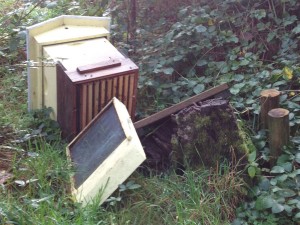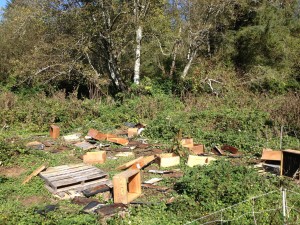Now that winter is settling in, it’s time to go around and check on my hives. By now the bees have snuggled in for the winter dormancy, and ideally they’ve stocked up on honey to get themselves through the winter (assuming, of course, the beekeeper didn’t take too much, which he didn’t in this case). The best check is pretty simple: you grab the back of the hive, and try to lift it. If you can’t, there’s enough honey in it.
My first stop was at the Foss Road apiary. Our friends who run a beef business let me keep bees on their farm, and those hives are doing OK. This was their first year, so they are still “new-bees” and aren’t yet at full honey production. Though heavy, I was able to lift each of them, so I fed them some sugar to help the bees bulk up for the holidays. Merry Christmas, ladies.
Moving on to the Miami Foley apiary, where we’ve been growing vegetables for the last four years. These hives have been around for a while, and it shows. All six of them were were WAY too heavy to lift, just brimming with honey. Despite the drizzle, there were even a few random bees patrolling around the entrances. But as I made my way through the orchard to the last hive, I saw a sight that stopped me cold, one no beekeeper ever wants to see:
 Disaster! Within the last few days, a stump I was using as a hive stand had disintegrated, dumping the hive on its back Luckily it didn’t go onto its side; when that happens, the combs collapse, flattening everyone between them. Luckily, it fell in the “right” direction, parallel to the comb. Unless the queen was unfortunate enough to get pinched, it will probably be fine after I right it.
Disaster! Within the last few days, a stump I was using as a hive stand had disintegrated, dumping the hive on its back Luckily it didn’t go onto its side; when that happens, the combs collapse, flattening everyone between them. Luckily, it fell in the “right” direction, parallel to the comb. Unless the queen was unfortunate enough to get pinched, it will probably be fine after I right it.
Which gets to the bad part, the part I like least in all of beekeeping. This is the third time I’ve had to pick up a tumbled hive (the other times were after a storm, and when I bumped one with the tractor) and I know from experience: the bees are not very amused about the situation. They are scared, defensive, and want to lash out and lay a heap of stinging on anyone dumb enough to be within reach. Despite the protective gear, I get stung several times whenever I do this.
But it’s part of the deal. So I sigh and shrug, and take my medicine. I only got three stings this time, but not for lack of trying on their part. I walked 200 yards from the site and still had a beard of really mad bees hanging on my veil, trying valiantly to put my face to the sword. But the hive is now upright, ready for winter, and I’ll be moving it to a new stand come springtime.
 So… you may have noticed I didn’t mention the third apiary at Gravel Creek. It’s taken me a while to make peace with what happened, but basically, a bear destroyed all 8 hives last month. In terms of life, it was a total loss: about a quarter of a million bees dead. I was able to clean up the mess and most of the woodenware is not broken (but has cool bear claw marks on it!), but it’s going to be about a thousand bucks to replace the bees… not to mention the entire year lost, as the bear ate all the brood, comb, honey, everything. I’ll be starting over next spring from scratch. It’s kindof my fault, as I didn’t keep up with the weeding, and aggressive plants choked out the electric fence and discharged it- allowing the bear to waltz right in do his thing. This image of my ruined apiary will be etched in my mind for some time to come.
So… you may have noticed I didn’t mention the third apiary at Gravel Creek. It’s taken me a while to make peace with what happened, but basically, a bear destroyed all 8 hives last month. In terms of life, it was a total loss: about a quarter of a million bees dead. I was able to clean up the mess and most of the woodenware is not broken (but has cool bear claw marks on it!), but it’s going to be about a thousand bucks to replace the bees… not to mention the entire year lost, as the bear ate all the brood, comb, honey, everything. I’ll be starting over next spring from scratch. It’s kindof my fault, as I didn’t keep up with the weeding, and aggressive plants choked out the electric fence and discharged it- allowing the bear to waltz right in do his thing. This image of my ruined apiary will be etched in my mind for some time to come.

